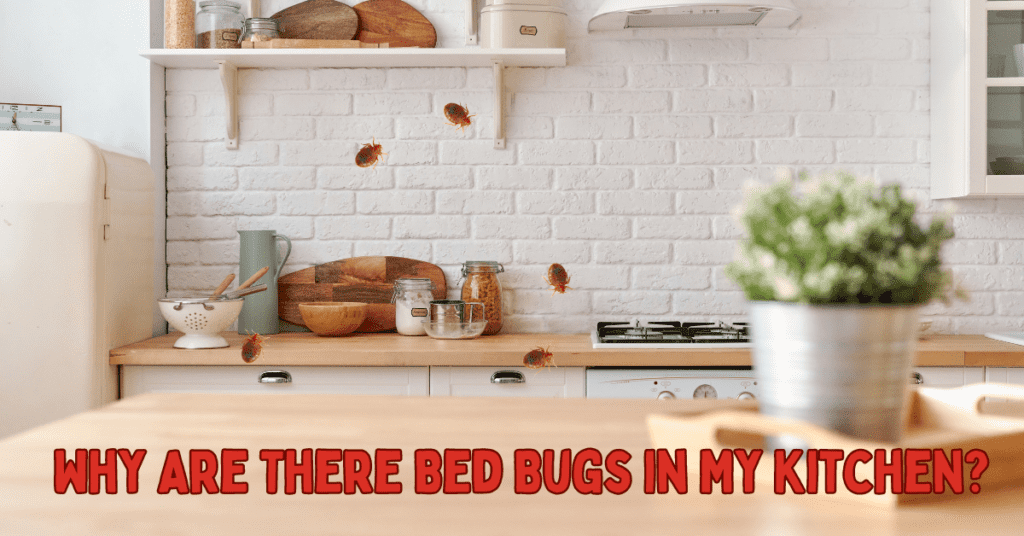Bugs in clothes: how to ID them and what to do if you find one. Imagine opening your closet to pick out an outfit, only to find tiny holes or an actual bug crawling or flying in your closet.
Around the world, there are countless creepy crawlies causing chaos in our wardrobes. But fear not; you’re about to become an expert on these wardrobe invaders. Knowledge is power, and you can identify any bugs in clothes with these insights.
In this article, we will present you with 10 examples of bugs that might be lurking in your clothes or closet. You will learn about the insects’ habitat, identifying features, and why they’re drawn to your wardrobe. Knowing their characteristics will give you the upper hand in preventing infestations and keeping your clothes safe.
Not only will you gain a deeper understanding of these closet critters, but you’ll also discover how to avoid inviting them into your home. We’ve got you covered, from simple storage solutions to effective methods.
So, let’s dive into the world of bugs in clothes and arm you with the knowledge you need to keep your wardrobe safe and sound.
Identifying Bugs in Clothes

When you come across bugs in your clothes, it’s essential to accurately identify them to determine the best course of action. Bugs can come in from outside and end up in your clothes without you even knowing it.
In this section, we’ll discuss three main categories of bugs: Fabric Pests, Pantry Pests, and Occasional Invaders.
Fabric Pests (Bugs in Clothes)
Fabric pests are insects that feed on and damage natural fibers in clothes, including:
- Clothes Moths: These small, winged insects prefer dark and secluded areas. They lay eggs on clothes made of wool, silk, or other natural materials. The larval stage of clothes moths is what causes the damage.
- Carpet Beetles: These small, round beetles have a varied diet, including fabric made from natural fibers. Like clothes moths, it’s their larvae that cause damage to your clothes.
To identify fabric pests, look for the following:
- Adult insects near your clothing storage areas
- Holes or damage to natural fiber clothing
- Larvae or pupae on or near clothes
Pantry Pests (Bugs in Clothes)
Pantry pests are usually found in kitchen areas but can also infiltrate clothing storage areas. Some common pantry pests include:
- Indian Meal Moths: You’ll find these tiny moths around stored food items which is why they are a top contender on our “bugs in flour” list. If they enter your clothing storage areas, they can lay eggs on clothes made of plant-based fibers like cotton or linen.
- Flour Beetles: Flour beetles infest grain-based products and may accidentally find their way to your clothing storage areas.
To identify pantry pests, look for:
- Adult insects in your kitchen or near your clothing storage areas
- Damaged clothing made from plant-based fibers
- What is included: 12 Cedar Hang Ups (not assembled) & 10 Cedar Balls. United States Based Seller. Perfect for clothes storage & clothes protection
- MULTIPLE USES: Use these cedar hang up, cedar planks and cedar balls in your closet, shoes, car and kitchen. Cedar blocks for clothes storage & clothes protection are not just for clothes storage
- NATURAL RED CEDAR WOOD: This product is made of natural red cedar wood sourced from North America and made without any added chemicals
- LASTING CEDAR SCENT: The original scent of red cedar is light and lasting so you may only smell the fragrance when placed under your nose but be assured that the scent is powerful to those unwanted guests
- SATISFACTION GUARANTEE: We stand behind our products with an exclusive no-hassle return or refund guarantee. If you have any issues or questions, please reach out to us, and we will ensure your problem will be solved quickly
Occasional Invaders (Bugs in Clothes)
Occasional invaders are bugs that can accidentally end up in your clothes but don’t typically feed on the fabric. These can include:
- Spiders: Spiders may wander into clothing storage areas seeking shelter or prey.
- Bed Bugs: They’ll usually find their way into your clothing by you putting something away that has a bug on it.
- Silverfish: These wingless insects like dark, damp environments and might accidentally wind up in your clothing storage areas.
- Lice or Fleas: If you have body lice they’ll live in your clothes. Fleas can also infest clothes if they are on the floor near pets.
To identify occasional invaders, look for:
- Adult insects that don’t fit the typical fabric or pantry pest profiles
- No apparent damage to your clothes from these insects
By identifying the type of bug in your clothes, you can take the appropriate steps to control these pests and protect your wardrobe.
Common Examples of Bugs in Clothes
Clothes Moths (Tineala bisselliella or Tinea pellionella)

You may find clothes moths mainly in closets, close to fabrics. These insects prefer wool, silk, leather, feathers, and cashmere. Sometimes they will also feed on dead rodents, so if you have a rodent issue where baits are used, it can, in turn, cause clothes moths to have a feeding frenzy.
The larvae are the real culprits, feeding on your clothes and leaving holes. To prevent damage, regularly vacuum and inspect your closet and store clothing in airtight bins.
Carpet Beetles (Dermestidae family)
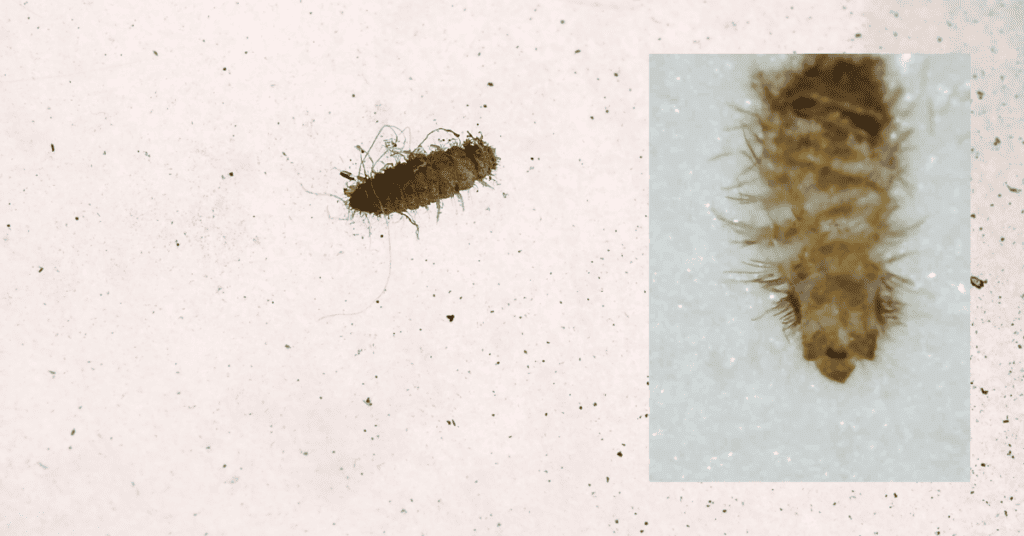
Adult carpet beetles generally live outdoors and feed on pollen and plants. More importantly, these bugs like laying eggs near natural fibers like silk, cotton, and wool. Furthermore, the larvae cause damage, so check for signs of infestation near your clothing.
Check out our in-depth article on them to learn more about the lifecycle of the carpet beetle. Vacuum regularly to prevent carpet beetle invasions.
Silverfish (Zygentoma order)

Silverfish thrive in moist, dark areas, such as closets and basements. They love clothing made of linen and cotton, which is why they are a top contender for “bugs in clothes.” To prevent silverfish infestations, reduce humidity and store clothes in airtight containers.
You’ll also want to inspect any books or paper with starch, gum, or glue. Silverfish are notorious for eating animal proteins that are in glue. So if you have wallpaper, you’ll probably have silverfish! Learn more on how to get rid of silverfish!
Bed Bugs (Cimex lectularius and Cimex hemipterus)
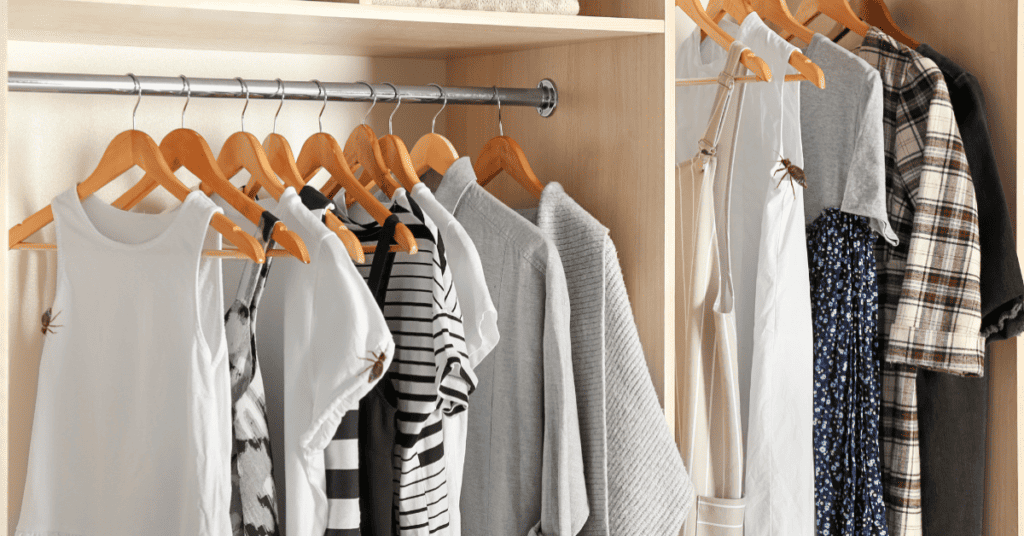
Bed bugs are common in and around sleeping areas but are bed bugs on clothes something you need to worry about? Yes, they can also infest clothing. These tiny insects feed on human blood.
Typical signs of infestation include droppings, shed skins, or baby bed bugs. Note: Bed bugs are not parasites that live on us. Instead, they live near us.
Here are a few of the common reasons why you’ll see bed bugs in your clothes:
- One crawled on you while you sat in public, then slipped into a seam or pocket on your clothes.
- Your bed has bed bugs, and you took some clothing that was sitting on your bed and placed it into the closet. You may have inadvertently just put a bed bug into your wardrobe.
- If your friend has bed bugs and sits in your car, one may crawl onto your clothing.
- You are using repellents near your infested bed and driving the bed bugs into different places like a closet or drawer.
Dust Mites (Dermatophagoides spp)
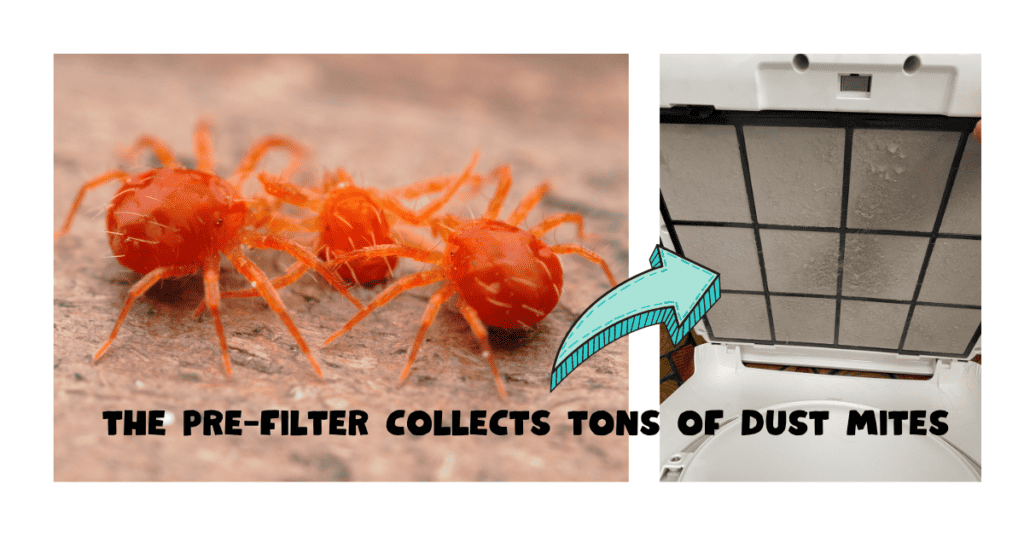
Dust mites live on organic materials, such as dead skin cells and dust. They may not damage your clothes directly but can trigger allergic reactions. Wash your clothes regularly and eliminate dust from your home to control dust mite populations.
We swear by the Coway air filter and put one in every room. It will trap dust in its multiple-layered filtration system. The filter has a pre-filter that you can vacuum monthly; the best thing is that you can visibly see all the dust it is trapping.
- Coway Mighty (AP-1512HH) is designed to accommodate room sizes up to 361 sq. ft (CADR: Dust 246 / Pollen 240 / Smoke 233 cb. ft. ).
- 4 Stage Filtration System (Pre-filter, Deodorization filter, True HEPA filter, Vital Ion) captures and reduces up to 99. 97% of particles 0. 3 microns in the air, including pollen, pollutants and other allergens. It also reduces volatile organic compounds and reduces odor.
- Coway Mighty pollution sensor communicates indoor air quality in real-time. The brightly colored LED lets you know how clean or dirty your indoor air is every minute of the day. And it features a timer, and filter lifetime indicator.
- Fan speeds available in 1, 2, 3 stages by manually setting up. While auto mode automatically optimizes the speed setting 1 through 3 based on the level of indoor air quality. When no pollution is detected for 30 minutes, the fan will automatically stop and set as Eco mode to save energy.
- Timer feature allows the machine to run 1/4/8 hours before automatically powering off.
To learn more, we teach you all about how to get rid of dust mites in our in-depth article.
Body Lice (Pediculus humanus humanus)

Body lice thrive on human blood and tend to live within our clothing. These insects cause itching and are slightly larger than head lice. A body louse is usually between 3-4mm, whereas a head louse is 2-3 mm. Maintain good hygiene, wash your clothes with hot water and a hot dryer to eliminate body lice.
Cockroaches (Blattidae and Blattellidae families)

Cockroaches are scavengers who chew on clothing materials or anything with food residue. If you have some dish towels or reusable napkins with food residue, they can attract roaches to chew through the material.
We wrote an entire article on this exact topic: “do cockroaches travel in clothes?”
Another way cockroaches can get on your clothing is if you stay in a hotel infested with roaches. In this case, you may take some hitchhikers home in your luggage.
Just know that there are plenty of bugs that look like cockroaches, so visit our contact page and send us a photo for identification.
Additionally, movie theaters are famous for cockroaches because of the popcorn and candy on the floors and seats. Be sure to wash and dry all clothing after visiting movie theatres or hotels.
Carpet Moths (Trichophaga tapetzella)
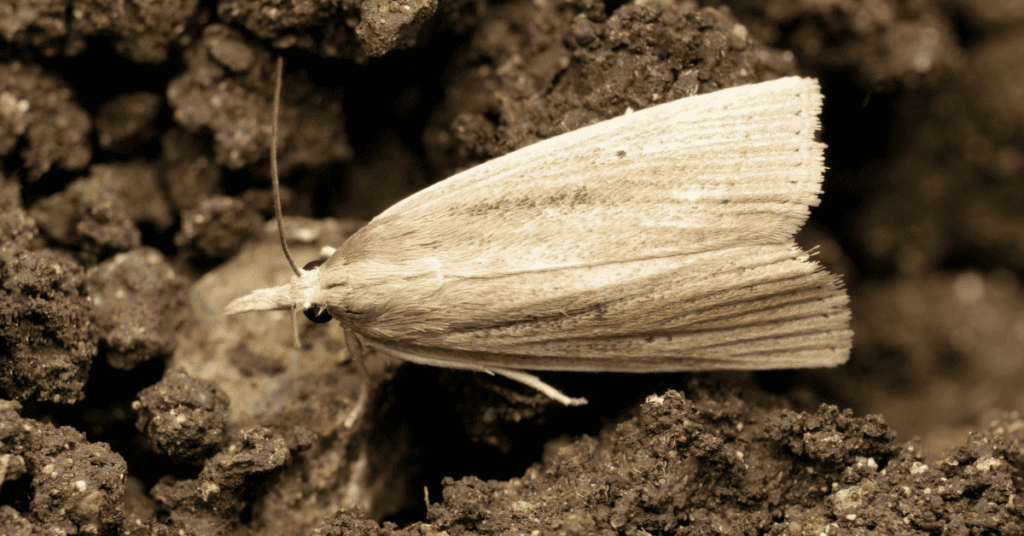
Carpet moths, like clothes moths, are drawn to natural fibers. One difference is that they are more significant than webbing clothes moths and casemaking clothes moths.
Furthermore their larvae can cause holes and damage to carpets and clothing. Vacuum your rugs regularly and use essential oils like bay leaves, cedar, lavender, mint, rosemary, and thyme to keep them away.
Booklice
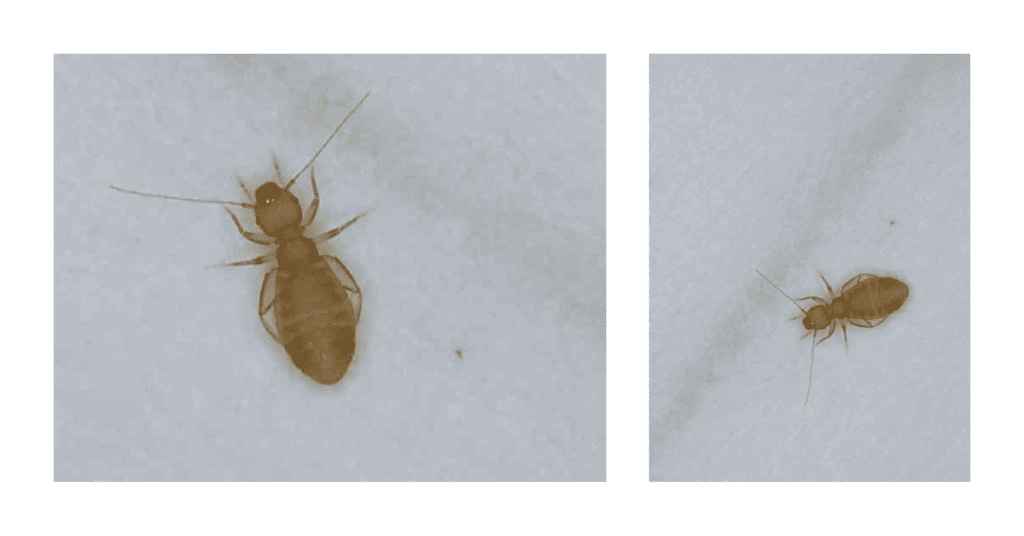
Booklice can infest paper products and fabrics, especially if you have mold or mildew. Since they are attracted to damp environments, you’ll need to monitor the humidity levels in your home.
Control humidity and clean regularly to prevent these insects from damaging your clothing. We use the Ninesky dehumidifier to control moisture levels in our bathroom. Decreasing the moisture and humidity will help get rid of booklice.
- Efficient Dehumidifiers for Home: 98 OZ dehumidifier for bedroom adopts semiconductor condensation technology, it can quickly and quietly remove moisture from the air, capable of removing up to 34 OZ/day (under 30℃, RH80% condition), Say goodbye to dampness and creating a comfortable home environment for you
- Auto Shut Off Protection: Smart dehumidifier for bathroom with auto shut off function when the water tank is full or in a wrong position, the red indicator light stays on indicates that the water tank needs to be adjusted to the correct position. If it flashes, reminds you that the water tank is full and needs empty, perfect to prevent the water from overflowing when you did not notice, very safe and convenient to use when you are not at home
- 5 Color Night Lights: Our dehumidifier for bedroom has an independent light button, 5 changing lights and you can choose your favorite color by clicking the light button, could serve as a nigh light, creates a sweet and romantic sleeping atmosphere for you
- Ultrl Quiet Dehumidifier: Our home dehumidifier adopts ultra-quiet technology, quietly operating (<40db) , it won't disturb your peace while effectively removing excess moisture from the air, creates a comfortable and peaceful environment for your bedroom and office, great choice to use in anytime or anywhere
- Portable Compact Dehumidifier: This portable dehumidifier size approx: 10(L)*6.1(W)*14.2(H) inch, could cover a range of 800 sq.ft. and back with ergonomic handle makes it easy to carry to different places. perfect to use as bedroom dehumidifier, bathroom dehumidifier. Widely used in living rooms, office, basement, garage, RVs, kitchen and other occcsions
Crickets (Gryllidae Family)

In rare instances, crickets may chew on your clothes, especially those made from natural fibers. Just like with roaches, if any of your clothing has food stains, a cricket may munch on it.
Since crickets are active at night and attracted to lights, they may find their way into your home if you have bright lights on your porch. Once in your home, they may end up in your laundry bin or closet, where they can become one of the bugs in your clothes.
Fix any cracks or crevices to prevent crickets from entering your home.
Preventing and Controlling Infestations
Regular Cleaning
To prevent infestations, regularly clean your home, especially areas where you store clothes. Vacuum and dust frequently to remove any insects or their eggs.
Pay extra attention to dark, undisturbed areas, such as closets and under beds, where pests may hide. Wash your clothes often and at the appropriate temperature to kill any bugs that may have crawled inside.
Air out stored clothes occasionally to ensure they don’t become a breeding ground for bugs.
Proper Storage
Properly storing clothes can reduce the risk of infestations. Use airtight containers or vacuum-sealed bags to store out-of-season clothing, making it difficult for pests to access your belongings.
You can use Cedar planks or cedar-lined storage spaces as a natural deterrent against insects.
For delicate garments, consider using acid-free storage boxes. Avoid damp areas and maintain a low humidity level in your home to help keep pests away.
Pest Control Methods
If bugs appear in your clothes, it’s essential to take action. Here are some pest control methods to consider:
- Natural repellents: Cedar, lavender, bay leaves, or mint can deter some pests. Remember that these methods may be less effective against an existing infestation.
- Traps: Pheromone traps can help capture and monitor pests in your home. Check and replace them regularly.
- Professional pest control: If your infestation becomes severe and difficult to manage, consider hiring a professional exterminator to help you devise an attack plan.
Following these tips and maintaining a clean, well-organized home can minimize the chances of bugs in your clothes.






